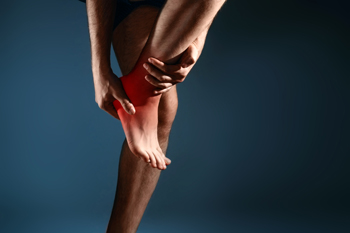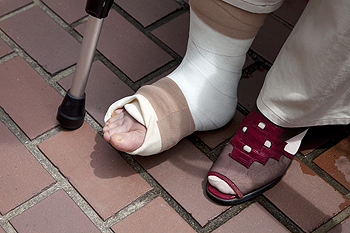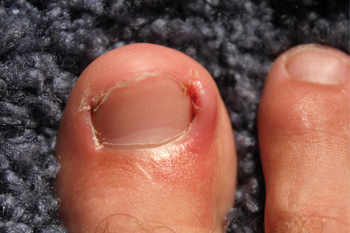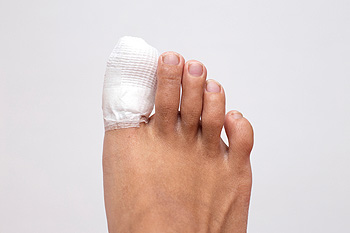





 Poor circulation may be indicative of existing medical conditions. Common symptoms of this condition may include a tingling or numbing sensation in the feet, severely dry skin, and your feet may feel unusually tired. There may be medical conditions and lifestyle habits that may cause poor circulation. Other causes may include smoking, eating unhealthy foods, and having high blood pressure. Research has indicated high stress levels may lead to elevated blood pressure, which can cause poor circulation as well. To help alleviate some stress, it may be beneficial to practice meditation. If you have symptoms of poor circulation, it is suggested that you seek the counsel of a podiatrist who can offer you correct treatment techniques.
Poor circulation may be indicative of existing medical conditions. Common symptoms of this condition may include a tingling or numbing sensation in the feet, severely dry skin, and your feet may feel unusually tired. There may be medical conditions and lifestyle habits that may cause poor circulation. Other causes may include smoking, eating unhealthy foods, and having high blood pressure. Research has indicated high stress levels may lead to elevated blood pressure, which can cause poor circulation as well. To help alleviate some stress, it may be beneficial to practice meditation. If you have symptoms of poor circulation, it is suggested that you seek the counsel of a podiatrist who can offer you correct treatment techniques.
While poor circulation itself isn’t a condition; it is a symptom of another underlying health condition you may have. If you have any concerns with poor circulation in your feet contact one of our podiatrists of Active Foot and Ankle Care, LLC. Our doctors will treat your foot and ankle needs.
Poor Circulation in the Feet
Peripheral artery disease (PAD) can potentially lead to poor circulation in the lower extremities. PAD is a condition that causes the blood vessels and arteries to narrow. In a linked condition called atherosclerosis, the arteries stiffen up due to a buildup of plaque in the arteries and blood vessels. These two conditions can cause a decrease in the amount of blood that flows to your extremities, therefore resulting in pain.
Symptoms
Some of the most common symptoms of poor circulation are:
Treatment for poor circulation often depends on the underlying condition that causes it. Methods for treatment may include insulin for diabetes, special exercise programs, surgery for varicose veins, or compression socks for swollen legs.
As always, see a podiatrist as he or she will assist in finding a regimen that suits you. A podiatrist can also prescribe you any needed medication.
If you have any questions, please feel free to contact our offices located in Fair Lawn and Riverdale, New Jersey. We offer the newest diagnostic and treatment technologies for all your foot care needs.
Read more about Causes Symptoms and Treatment for Poor Circulation in the Feet Poor circulation may be indicative of existing medical conditions. Common symptoms of this condition may include a tingling or numbing sensation in the feet, severely dry skin, and your feet may feel unusually tired. There may be medical conditions and lifestyle habits that may cause poor circulation. Other causes may include smoking, eating unhealthy foods, and having high blood pressure. Research has indicated high stress levels may lead to elevated blood pressure, which can cause poor circulation as well. To help alleviate some stress, it may be beneficial to practice meditation. If you have symptoms of poor circulation, it is suggested that you seek the counsel of a podiatrist who can offer you correct treatment techniques.
Poor circulation may be indicative of existing medical conditions. Common symptoms of this condition may include a tingling or numbing sensation in the feet, severely dry skin, and your feet may feel unusually tired. There may be medical conditions and lifestyle habits that may cause poor circulation. Other causes may include smoking, eating unhealthy foods, and having high blood pressure. Research has indicated high stress levels may lead to elevated blood pressure, which can cause poor circulation as well. To help alleviate some stress, it may be beneficial to practice meditation. If you have symptoms of poor circulation, it is suggested that you seek the counsel of a podiatrist who can offer you correct treatment techniques.
While poor circulation itself isn’t a condition; it is a symptom of another underlying health condition you may have. If you have any concerns with poor circulation in your feet contact one of our podiatrists of Active Foot and Ankle Care, LLC. Our doctors will treat your foot and ankle needs.
Poor Circulation in the Feet
Peripheral artery disease (PAD) can potentially lead to poor circulation in the lower extremities. PAD is a condition that causes the blood vessels and arteries to narrow. In a linked condition called atherosclerosis, the arteries stiffen up due to a buildup of plaque in the arteries and blood vessels. These two conditions can cause a decrease in the amount of blood that flows to your extremities, therefore resulting in pain.
Symptoms
Some of the most common symptoms of poor circulation are:
Treatment for poor circulation often depends on the underlying condition that causes it. Methods for treatment may include insulin for diabetes, special exercise programs, surgery for varicose veins, or compression socks for swollen legs.
As always, see a podiatrist as he or she will assist in finding a regimen that suits you. A podiatrist can also prescribe you any needed medication.
If you have any questions, please feel free to contact our offices located in Fair Lawn, Riverdale, and Englewood, NJ . We offer the newest diagnostic and treatment technologies for all your foot care needs.
 The bones in the foot that are fractured the most are known as the metatarsal bones. They consist of five bones that run the length of the foot, and end at the bottom of the toes. A broken foot can be the result of a sudden injury that may occur in sporting activities, or it can happen from unexpectedly stepping off a curb, where it may become severely twisted. Stress injuries may also cause a broken foot, and this can gradually occur from performing repetitive running or jumping activities. Common symptoms that are associated with this condition can include severe bruising, immediate pain on or around the affected area, and it is uncomfortable to walk and put weight on the foot. If you feel you may have broken your foot, it is suggested that you speak with a podiatrist as quickly as possible who can perform a proper diagnosis and begin the correct treatment.
The bones in the foot that are fractured the most are known as the metatarsal bones. They consist of five bones that run the length of the foot, and end at the bottom of the toes. A broken foot can be the result of a sudden injury that may occur in sporting activities, or it can happen from unexpectedly stepping off a curb, where it may become severely twisted. Stress injuries may also cause a broken foot, and this can gradually occur from performing repetitive running or jumping activities. Common symptoms that are associated with this condition can include severe bruising, immediate pain on or around the affected area, and it is uncomfortable to walk and put weight on the foot. If you feel you may have broken your foot, it is suggested that you speak with a podiatrist as quickly as possible who can perform a proper diagnosis and begin the correct treatment.
A broken foot requires immediate medical attention and treatment. If you need your feet checked, contact one of our podiatrists from Active Foot and Ankle Care, LLC. Our doctors can provide the care you need to keep you pain-free and on your feet.
Broken Foot Causes, Symptoms, and Treatment
A broken foot is caused by one of the bones in the foot typically breaking when bended, crushed, or stretched beyond its natural capabilities. Usually the location of the fracture indicates how the break occurred, whether it was through an object, fall, or any other type of injury.
Common Symptoms of Broken Feet:
Those that suspect they have a broken foot shoot seek urgent medical attention where a medical professional could diagnose the severity.
Treatment for broken bones varies depending on the cause, severity and location. Some will require the use of splints, casts or crutches while others could even involve surgery to repair the broken bones. Personal care includes the use of ice and keeping the foot stabilized and elevated.
If you have any questions please feel free to contact our offices located in Fair Lawn and Riverdale, New Jersey. We offer the newest diagnostic and treatment technologies for all your foot and ankle needs.
Read more about Causes, Symptoms, and Treatment for a Broken Foot The bones in the foot that are fractured the most are known as the metatarsal bones. They consist of five bones that run the length of the foot, and end at the bottom of the toes. A broken foot can be the result of a sudden injury that may occur in sporting activities, or it can happen from unexpectedly stepping off a curb, where it may become severely twisted. Stress injuries may also cause a broken foot, and this can gradually occur from performing repetitive running or jumping activities. Common symptoms that are associated with this condition can include severe bruising, immediate pain on or around the affected area, and it is uncomfortable to walk and put weight on the foot. If you feel you may have broken your foot, it is suggested that you speak with a podiatrist as quickly as possible who can perform a proper diagnosis and begin the correct treatment.
The bones in the foot that are fractured the most are known as the metatarsal bones. They consist of five bones that run the length of the foot, and end at the bottom of the toes. A broken foot can be the result of a sudden injury that may occur in sporting activities, or it can happen from unexpectedly stepping off a curb, where it may become severely twisted. Stress injuries may also cause a broken foot, and this can gradually occur from performing repetitive running or jumping activities. Common symptoms that are associated with this condition can include severe bruising, immediate pain on or around the affected area, and it is uncomfortable to walk and put weight on the foot. If you feel you may have broken your foot, it is suggested that you speak with a podiatrist as quickly as possible who can perform a proper diagnosis and begin the correct treatment.
A broken foot requires immediate medical attention and treatment. If you need your feet checked, contact one of our podiatrists from Active Foot and Ankle Care, LLC. Our doctors can provide the care you need to keep you pain-free and on your feet.
Broken Foot Causes, Symptoms, and Treatment
A broken foot is caused by one of the bones in the foot typically breaking when bended, crushed, or stretched beyond its natural capabilities. Usually the location of the fracture indicates how the break occurred, whether it was through an object, fall, or any other type of injury.
Common Symptoms of Broken Feet:
Those that suspect they have a broken foot shoot seek urgent medical attention where a medical professional could diagnose the severity.
Treatment for broken bones varies depending on the cause, severity and location. Some will require the use of splints, casts or crutches while others could even involve surgery to repair the broken bones. Personal care includes the use of ice and keeping the foot stabilized and elevated.
If you have any questions please feel free to contact our offices located in Fair Lawn, Riverdale, and Englewood, NJ . We offer the newest diagnostic and treatment technologies for all your foot and ankle needs.
Read more about Causes, Symptoms, and Treatment for a Broken Foot During pregnancy, your body goes through a number of changes. Most obviously, a woman will gain a significant amount of weight. In turn, this causes the feet to now bear the weight of two. Due to the additional weight, the feet must now adjust to the increased pressure that is placed upon them. This may cause the feet to swell or ache, and your style of walking may become altered as well. To help reduce discomfort, it can be beneficial to regularly perform low impact exercises, for example going for a light stroll. It can also be helpful to avoid standing for long periods of time, periodically stretching, and wearing compression socks to encourage blood flow. For professional care, it’s suggested that you speak with a podiatrist for more information on foot care during pregnancy.
During pregnancy, your body goes through a number of changes. Most obviously, a woman will gain a significant amount of weight. In turn, this causes the feet to now bear the weight of two. Due to the additional weight, the feet must now adjust to the increased pressure that is placed upon them. This may cause the feet to swell or ache, and your style of walking may become altered as well. To help reduce discomfort, it can be beneficial to regularly perform low impact exercises, for example going for a light stroll. It can also be helpful to avoid standing for long periods of time, periodically stretching, and wearing compression socks to encourage blood flow. For professional care, it’s suggested that you speak with a podiatrist for more information on foot care during pregnancy.
Pregnant women with swollen feet can be treated with a variety of different methods that are readily available. For more information about other cures for swollen feet during pregnancy, consult with one of our podiatrists from Active Foot and Ankle Care, LLC. Our doctors will attend to all of your foot and ankle needs.
What Foot Problems Can Arise During Pregnancy?
One problem that can occur is overpronation, which occurs when the arch of the foot flattens and tends to roll inward. This can cause pain and discomfort in your heels while you’re walking or even just standing up, trying to support your baby.
Another problem is edema, or swelling in the extremities. This often affects the feet during pregnancy but tends to occur in the later stages.
How Can I Keep My Feet Healthy During Pregnancy?
If you have any questions please feel free to contact our offices located in Fair Lawn and Riverdale, New Jersey. We offer the newest diagnostic and treatment technologies for all your foot and ankle needs.
Read more about Pregnancy and Foot Health During pregnancy, your body goes through a number of changes. Most obviously, a woman will gain a significant amount of weight. In turn, this causes the feet to now bear the weight of two. Due to the additional weight, the feet must now adjust to the increased pressure that is placed upon them. This may cause the feet to swell or ache, and your style of walking may become altered as well. To help reduce discomfort, it can be beneficial to regularly perform low impact exercises, for example going for a light stroll. It can also be helpful to avoid standing for long periods of time, periodically stretching, and wearing compression socks to encourage blood flow. For professional care, it’s suggested that you speak with a podiatrist for more information on foot care during pregnancy.
During pregnancy, your body goes through a number of changes. Most obviously, a woman will gain a significant amount of weight. In turn, this causes the feet to now bear the weight of two. Due to the additional weight, the feet must now adjust to the increased pressure that is placed upon them. This may cause the feet to swell or ache, and your style of walking may become altered as well. To help reduce discomfort, it can be beneficial to regularly perform low impact exercises, for example going for a light stroll. It can also be helpful to avoid standing for long periods of time, periodically stretching, and wearing compression socks to encourage blood flow. For professional care, it’s suggested that you speak with a podiatrist for more information on foot care during pregnancy.
Pregnant women with swollen feet can be treated with a variety of different methods that are readily available. For more information about other cures for swollen feet during pregnancy, consult with one of our podiatrists from Active Foot and Ankle Care, LLC. Our doctors will attend to all of your foot and ankle needs.
What Foot Problems Can Arise During Pregnancy?
One problem that can occur is overpronation, which occurs when the arch of the foot flattens and tends to roll inward. This can cause pain and discomfort in your heels while you’re walking or even just standing up, trying to support your baby.
Another problem is edema, or swelling in the extremities. This often affects the feet during pregnancy but tends to occur in the later stages.
How Can I Keep My Feet Healthy During Pregnancy?
If you have any questions please feel free to contact our offices located in Fair Lawn, Riverdale, and Englewood, NJ . We offer the newest diagnostic and treatment technologies for all your foot and ankle needs.
 An ingrown toenail is a common foot ailment among many patients. It occurs as a result of the toenail growing into the side edges of the nail, and can cause severe pain and discomfort. It may develop when there is inadequate room in the toe area of shoes that are worn, or from improperly trimming the toenails. Some of the symptoms patients often experience with this condition can consist of swelling, redness on or around the affected area, and in severe cases, there may be a discharge coming from the nail. It may be beneficial to soak the foot in warm water, which can help to soften the nail. It is suggested that you consult with a podiatrist who can recommend the best treatment option for you, which may involve surgery to partially remove the affected nail.
An ingrown toenail is a common foot ailment among many patients. It occurs as a result of the toenail growing into the side edges of the nail, and can cause severe pain and discomfort. It may develop when there is inadequate room in the toe area of shoes that are worn, or from improperly trimming the toenails. Some of the symptoms patients often experience with this condition can consist of swelling, redness on or around the affected area, and in severe cases, there may be a discharge coming from the nail. It may be beneficial to soak the foot in warm water, which can help to soften the nail. It is suggested that you consult with a podiatrist who can recommend the best treatment option for you, which may involve surgery to partially remove the affected nail.
Ingrown toenails can become painful if they are not treated properly. For more information about ingrown toenails, contact one of our podiatrists of Active Foot and Ankle Care, LLC. Our doctors can provide the care you need to keep you pain-free and on your feet.
Ingrown Toenails
Ingrown toenails occur when a toenail grows sideways into the bed of the nail, causing pain, swelling, and possibly infection.
Causes
Prevention
Because ingrown toenails are not something found outside of shoe-wearing cultures, going barefoot as often as possible will decrease the likeliness of developing ingrown toenails. Wearing proper fitting shoes and using proper cutting techniques will also help decrease your risk of developing ingrown toenails.
Treatment
Ingrown toenails are a very treatable foot condition. In minor cases, soaking the affected area in salt or antibacterial soaps will not only help with the ingrown nail itself, but also help prevent any infections from occurring. In more severe cases, surgery is an option. In either case, speaking to your podiatrist about this condition will help you get a better understanding of specific treatment options that are right for you.
If you have any questions please feel free to contact our offices located in Fair Lawn and Riverdale, New Jersey. We offer the newest diagnostic and treatment technologies for all your foot and ankle needs.
Read more about Ingrown Toenail Care An ingrown toenail is a common foot ailment among many patients. It occurs as a result of the toenail growing into the side edges of the nail, and can cause severe pain and discomfort. It may develop when there is inadequate room in the toe area of shoes that are worn, or from improperly trimming the toenails. Some of the symptoms patients often experience with this condition can consist of swelling, redness on or around the affected area, and in severe cases, there may be a discharge coming from the nail. It may be beneficial to soak the foot in warm water, which can help to soften the nail. It is suggested that you consult with a podiatrist who can recommend the best treatment option for you, which may involve surgery to partially remove the affected nail.
An ingrown toenail is a common foot ailment among many patients. It occurs as a result of the toenail growing into the side edges of the nail, and can cause severe pain and discomfort. It may develop when there is inadequate room in the toe area of shoes that are worn, or from improperly trimming the toenails. Some of the symptoms patients often experience with this condition can consist of swelling, redness on or around the affected area, and in severe cases, there may be a discharge coming from the nail. It may be beneficial to soak the foot in warm water, which can help to soften the nail. It is suggested that you consult with a podiatrist who can recommend the best treatment option for you, which may involve surgery to partially remove the affected nail.
Ingrown toenails can become painful if they are not treated properly. For more information about ingrown toenails, contact one of our podiatrists of Active Foot and Ankle Care, LLC. Our doctors can provide the care you need to keep you pain-free and on your feet.
Ingrown Toenails
Ingrown toenails occur when a toenail grows sideways into the bed of the nail, causing pain, swelling, and possibly infection.
Causes
Prevention
Because ingrown toenails are not something found outside of shoe-wearing cultures, going barefoot as often as possible will decrease the likeliness of developing ingrown toenails. Wearing proper fitting shoes and using proper cutting techniques will also help decrease your risk of developing ingrown toenails.
Treatment
Ingrown toenails are a very treatable foot condition. In minor cases, soaking the affected area in salt or antibacterial soaps will not only help with the ingrown nail itself, but also help prevent any infections from occurring. In more severe cases, surgery is an option. In either case, speaking to your podiatrist about this condition will help you get a better understanding of specific treatment options that are right for you.
If you have any questions please feel free to contact our offices located in Fair Lawn, Riverdale, and Englewood, NJ . We offer the newest diagnostic and treatment technologies for all your foot and ankle needs.
 A broken toe is typically not a serious condition, despite the fact that it may cause severe pain and discomfort. It may happen as a result of stubbing your toe against a piece of furniture, or possibly from dropping a heavy object on it. Immediate symptoms may include bruising and swelling on or around the affected toe, difficulty in walking, and the toe may appear deformed. Many patients have found buddy taping to be an effective treatment method for mildly broken toes. This is accomplished by taping the injured toe to the toe next to it. This method may be helpful in providing the necessary support as the healing process takes place. If you have broken your toe, it is suggested that you consult with a podiatrist who can help you to determine which treatment option is best for you.
A broken toe is typically not a serious condition, despite the fact that it may cause severe pain and discomfort. It may happen as a result of stubbing your toe against a piece of furniture, or possibly from dropping a heavy object on it. Immediate symptoms may include bruising and swelling on or around the affected toe, difficulty in walking, and the toe may appear deformed. Many patients have found buddy taping to be an effective treatment method for mildly broken toes. This is accomplished by taping the injured toe to the toe next to it. This method may be helpful in providing the necessary support as the healing process takes place. If you have broken your toe, it is suggested that you consult with a podiatrist who can help you to determine which treatment option is best for you.
Broken toes may cause a lot of pain and should be treated as soon as possible. If you have any concerns about your feet, contact one of our podiatrists from Active Foot and Ankle Care, LLC. Our doctors will treat your foot and ankle needs.
What Is a Broken Toe?
A broken toe occurs when one or more of the toe bones of the foot are broken after an injury. Injuries such as stubbing your toe or dropping a heavy object on it may cause a toe fracture.
Symptoms of a Broken Toe
Although the injured toe should be monitored daily, it is especially important to have a podiatrist look at your toe if you have severe symptoms. Some of these symptoms include worsening or new pain that is not relieved with medication, sores, redness, or open wounds near the toe.
If you have any questions, please feel free to contact our offices located in Fair Lawn and Riverdale, New Jersey. We offer the newest diagnostic and treatment technologies for all your foot care needs.
Read more about What to Know About a Broken Toe A broken toe is typically not a serious condition, despite the fact that it may cause severe pain and discomfort. It may happen as a result of stubbing your toe against a piece of furniture, or possibly from dropping a heavy object on it. Immediate symptoms may include bruising and swelling on or around the affected toe, difficulty in walking, and the toe may appear deformed. Many patients have found buddy taping to be an effective treatment method for mildly broken toes. This is accomplished by taping the injured toe to the toe next to it. This method may be helpful in providing the necessary support as the healing process takes place. If you have broken your toe, it is suggested that you consult with a podiatrist who can help you to determine which treatment option is best for you.
A broken toe is typically not a serious condition, despite the fact that it may cause severe pain and discomfort. It may happen as a result of stubbing your toe against a piece of furniture, or possibly from dropping a heavy object on it. Immediate symptoms may include bruising and swelling on or around the affected toe, difficulty in walking, and the toe may appear deformed. Many patients have found buddy taping to be an effective treatment method for mildly broken toes. This is accomplished by taping the injured toe to the toe next to it. This method may be helpful in providing the necessary support as the healing process takes place. If you have broken your toe, it is suggested that you consult with a podiatrist who can help you to determine which treatment option is best for you.
Broken toes may cause a lot of pain and should be treated as soon as possible. If you have any concerns about your feet, contact one of our podiatrists from Active Foot and Ankle Care, LLC. Our doctors will treat your foot and ankle needs.
What Is a Broken Toe?
A broken toe occurs when one or more of the toe bones of the foot are broken after an injury. Injuries such as stubbing your toe or dropping a heavy object on it may cause a toe fracture.
Symptoms of a Broken Toe
Although the injured toe should be monitored daily, it is especially important to have a podiatrist look at your toe if you have severe symptoms. Some of these symptoms include worsening or new pain that is not relieved with medication, sores, redness, or open wounds near the toe.
If you have any questions, please feel free to contact our offices located in Fair Lawn, Riverdale, and Englewood, NJ . We offer the newest diagnostic and treatment technologies for all your foot care needs.






